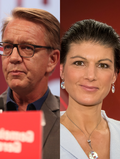
Back Bundestagswahl 2017 ALS الانتخابات الفيدرالية الألمانية 2017 Arabic Bundesdogswoi 2017 BAR Парламенцкія выбары ў Германіі (2017) Byelorussian Выбары ў Бундэстаг 2017 году BE-X-OLD Федерални избори в Германия (2017) Bulgarian Eleccions federals alemanyes de 2017 Catalan Německé volby do spolkového sněmu 2017 Czech Forbundsdagsvalget 2017 Danish Bundestagswahl 2017 German
This section needs additional citations for verification. (September 2017) |
| |||||||||||||||||||||||||||||||||||||||||||||||||||||||||||||||||||||||||||||||||||||
All 709 seats in the Bundestag (including overhang and leveling seats) 355 seats needed for a majority | |||||||||||||||||||||||||||||||||||||||||||||||||||||||||||||||||||||||||||||||||||||
|---|---|---|---|---|---|---|---|---|---|---|---|---|---|---|---|---|---|---|---|---|---|---|---|---|---|---|---|---|---|---|---|---|---|---|---|---|---|---|---|---|---|---|---|---|---|---|---|---|---|---|---|---|---|---|---|---|---|---|---|---|---|---|---|---|---|---|---|---|---|---|---|---|---|---|---|---|---|---|---|---|---|---|---|---|---|
| Opinion polls | |||||||||||||||||||||||||||||||||||||||||||||||||||||||||||||||||||||||||||||||||||||
| Registered | 61,688,485 ( | ||||||||||||||||||||||||||||||||||||||||||||||||||||||||||||||||||||||||||||||||||||
| Turnout | 76.2% ( | ||||||||||||||||||||||||||||||||||||||||||||||||||||||||||||||||||||||||||||||||||||
| |||||||||||||||||||||||||||||||||||||||||||||||||||||||||||||||||||||||||||||||||||||
 The left side shows constituency winners of the election by their party colours. The right side shows party list winners of the election for the additional members by their party colours. | |||||||||||||||||||||||||||||||||||||||||||||||||||||||||||||||||||||||||||||||||||||
| |||||||||||||||||||||||||||||||||||||||||||||||||||||||||||||||||||||||||||||||||||||
| This article is part of a series on the |
| Politics of Germany |
|---|
 |
Federal elections were held in Germany on 24 September 2017 to elect the members of the 19th Bundestag. At stake were at least 598 seats in the Bundestag, as well as 111 overhang and leveling seats determined thereafter.
The Christian Democratic Union of Germany and the Christian Social Union of Bavaria (CDU/CSU), led by incumbent chancellor Angela Merkel, won the highest percentage of the vote with 33%, though it suffered a large swing against it of more than 8%. The Social Democratic Party of Germany (SPD) achieved its worst result since post-war Germany at 21%. Alternative for Germany (AfD), which was previously unrepresented in the Bundestag, became the third party in the Bundestag with 12.6% of the vote, whilst the Free Democratic Party (FDP) won 10.7% of the vote and returned to the Bundestag after losing all their seats in 2013. It was the first time since 1957 that a party to the political right of the CDU/CSU gained seats in the Bundestag. The other parties to achieve representation in the Bundestag were the Left and Alliance 90/The Greens, each close to 9% of the vote. In the 709 member Bundestag, a majority is 355 and the CDU/CSU won 246 seats (200 CDU and 46 CSU), the SPD 153, the AfD 94, the FDP 80, The Left 69, and the Greens 67.
For the second consecutive occasion, the CDU/CSU reached a coalition agreement with the SPD to form a grand coalition, the fourth in post-war German history, and the new government took office on 14 March 2018. The agreement came after a failed attempt by the CDU/CSU to enter into a Jamaica coalition with the Greens and the FDP, which the latter pulled out of citing irreconcilable differences between the parties on migration and energy policy. This had been by far the longest government formation in the history of the Federal Republic of Germany, as it was the first time a proposed coalition formation negotiation had collapsed and had been replaced by another coalition.





